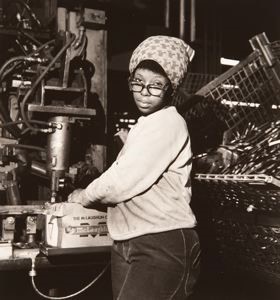Working People
I wanted to show who did the toughest work in industry. I wanted to show them because nobody does.
—Milton Rogovin
In the late 1970s, Rogovin focused intensely on documenting workers in heavy industry, such as steel mills and foundries. Photographing his subjects at work, and then in their home, he captured the person as a whole, not simply as a laborer. Rogovin was adamant to “find” his scene rather than stage it. Workers posed as they were, in the dismal light conditions of their workplace. Later, at home, they had the opportunity to create the scene they desired. Rogovin never dictated how they should dress or where they should pose.
In this series, near darkness surrounds the workers; the only light source comes from the flash of the camera. At home, the individuals express pride as they proudly display their possessions. In one photograph, the subject has prominently placed the image by Rogovin of himself at work on the mantel next to religious images (2011.16.21). This was an important part of Rogovin’s photographic practice: he was not able to pay his subjects, but he always gave them a high-quality print of the photograph they allowed him to take.

